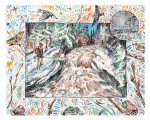THEY SAY SPRING ADVANCES fifteen miles a day, about the pace of a steady walk, which explains why I could experience three springs that year. The first was in March, in Ohio, on the shore of Lake Erie’s Maumee Bay, where I stayed in a small cabin near the bay to watch new grass sprouting in farmers’ fields and the broad-winged hawks that congregate in kettles high overhead. I counted a couple hundred broad-wings one day, which I thought was spectacular, but a local birder said they sometimes numbered in the tens of thousands—entire galaxies of spiral formations spinning slowly northward with the wind. In the marshes and woodlots were other early migrants: red-winged blackbirds, yellow-rumped warblers, ruby- and golden-crowned kinglets, and a brown thrasher that perched on the topmost branch of a tree beside my cabin one morning and performed tireless variations on the theme of “Here I am, look at me!”
Three weeks later, as I drove home, those same birds were showing up 300 miles north, in the northern Lower Peninsula of Michigan. The snow had finally left our yard and the woods out back, and forsythia and trillium were starting to blossom. Suddenly trout were feeding on mayflies in the rivers, morels were popping beneath the aspens, and butter-butts and kinglets were flitting among the bare branches of the trees.
Then it was time for the third spring, so I drove north again, crossed the Mackinac Bridge to the Upper Peninsula, and followed a network of gravel roads until I banged up against the shore of Superior. I had the key to a friend’s cabin, but I had to shovel the snow away before I could reach the door. The ice was off the big lake—it was brilliant blue water to the horizon—but stranded on the beach were remnant icebergs spangled with sand. I looked up and saw two dozen broad-winged hawks circling high overhead, waiting for a south wind to carry them across the lake to Ontario.
Spring is the most complicated season. It arrives pulling a clanging train of machinery, and we realize that the name we’ve given it is all wrong. It doesn’t spring, it saunters—two steps forward, one back—and often it retreats like a child in a sulk and we have to wait a few days or a week before it returns.
One morning I stepped from my friend’s cabin on Lake Superior and was met by the first warm wind of the season. A familiar call sounded high overhead and I looked up to see a loon hurtling past, bound for Canada. Then came another, and another, each trailing its ululating warble.
It was the clarion announcement, the emblem of the wild north, a song that stirs primordial urges in many of us who cherish unspoiled places. It’s the music of mist-shrouded lakes deep in the spruce forest, a boreal timelessness that is perhaps best heard from a canoe. Coming from the sky above Superior it was this and more: the sound of wildness in transit, winging north with the lengthening days of this season of hope.


17 Replies